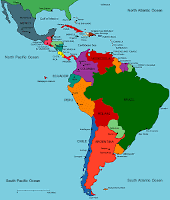
Australia, also known as Sahul, is the smallest of the geographic continents, though not of geological continents.[1] There is no universally accepted definition of the word "continent"; the lay definition is "One of the main continuous bodies of land on the earth's surface." (Oxford English Dictionary). By that definition, the continent of Australia includes only the Australian mainland, and not nearby islands such as New Guinea. From the perspective of geology or physical geography, however, a "continent" may be understood to include the continental shelf (the submerged adjacent area) and the islands on the shelf, which are taken to be structurally part of the continent. By that definition Tasmania, New Guinea and other nearby islands such as the Aru Islands and Raja Ampat Islands are part of the Australian continent since they are part of the same geological landmass. These islands are separated by seas overlying the continental shelf — the Arafura Sea and Torres Strait between Australia and New Guinea, the Timor Sea between Australia and Timor, and Bass Strait between mainland Australia and Tasmania.

Eu
rope (/ˈjʊərəp/ YOOR-əp[1]) is, by convention, one of the world's seven continents. Comprising the westernmost peninsula of Eurasia, Europe is generally divided from Asia to its east by the water divide of the Ural Mountains, the Ural River, the Caspian Sea, the Caucasus region (Specification of borders) and the Black Sea to the southeast.[2] Europe is bordered by the Arctic Ocean and other bodies of water to the north, the Atlantic Ocean to the west, the Mediterranean Sea to the south, and the Black Sea and connected waterways to the southeast. Yet the borders for Europe—a concept dating back to classical antiquity—are somewhat arbitrary, as the term continent can refer to a cultural and political distinction or a physiographic one.
Europe is the world's second-smallest continent by surface area, covering about 10,180,000 square kilometres (3,930,000 sq mi) or 2% of the Earth's surface and about 6.8% of its land area. Of Europe's approximately 50 states, Russia is the largest by both area and population (although the country covers both Europe and Asia), while the Vatican City is the smallest. Europe is the third-most populous continent after Asia and Africa, with a population of 731 million or about 11% of the world's population. However, according to the United Nations (medium estimate), Europe's share may fall to about 7% by 2050.[3] In 1900, Europe's share of the world's population was 25%.[4]

North America (Spanish: América del Norte or Norteamérica; French: Amérique du Nord) is the northern continent of the Americas,[4] situated in the Earth's northern hemisphere and in the western hemisphere. It is bordered on the north by the Arctic Ocean, on the east by the North Atlantic Ocean, on the southeast by the Caribbean Sea, and on the west by the North Pacific Ocean; South America lies to the southeast. North America covers an area of about 24,709,000 square kilometers (9,540,000 square miles), about 4.8% of the planet's surface or about 16.5% of its land area. As of July 2008, its population was estimated at nearly 529 million people. It is the third-largest continent in area, following Asia and Africa, and the fourth in population after Asia, Africa, and Europe.

Africa is the world's second-largest and second most-populous continent, after Asia. At about 30.2 million km² (11.7 million sq mi) including adjacent islands, it covers 6% of the Earth's total surface area and 20.4% of the total land area.[2] With a billion people (as of 2009, see table) in 61 territories, it accounts for about 14.72% of the World's human population. The continent is surrounded by the Mediterranean Sea to the north, both the Suez Canal and the Red Sea along the Sinai Peninsula to the northeast, the Indian Ocean to the southeast, and the Atlantic Ocean to the west. The continent has 54 states, including Madagascar, various island groups, and the Sahrawi Arab Democratic Republic, a member state of the African Union whose statehood is disputed by Morocco.






